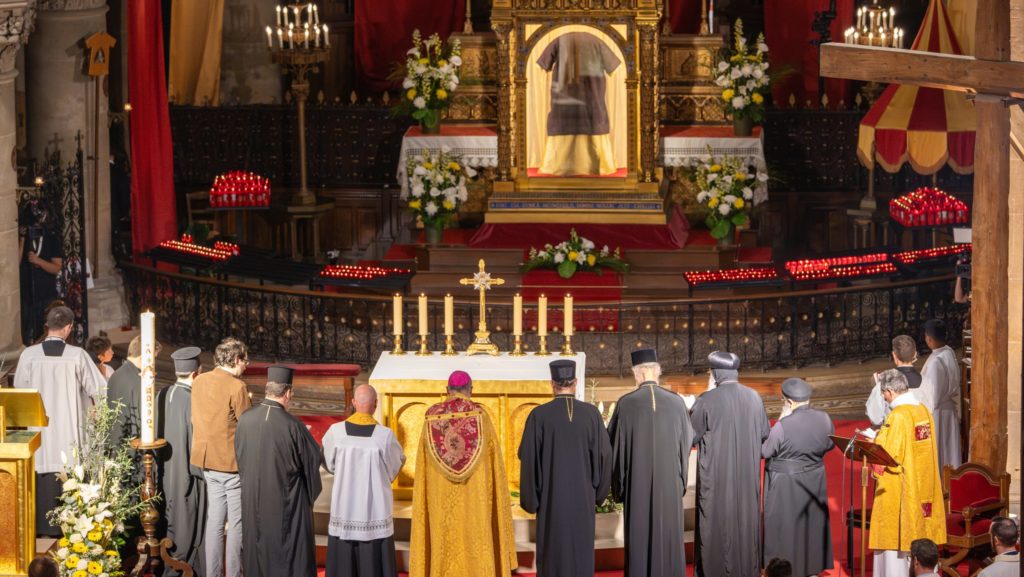As cardinals gather in Rome ahead of the May 7 conclave, thousands of pilgrims are flocking to the Basilica of St. Denis in Argenteuil, France, to venerate what's believed to be the holy tunic of Jesus -- the seamless robe described in the Gospels.
On display until May 11, the relic has drawn intense devotion, particularly following the recent death of Pope Francis.
Several cardinals now in Rome for the general congregations, being held to prepare for the conclave, were supposed to be venerating the tunic of Argenteuil, but instead the faithful pray for church unity and the next pope in front of the robe believed to be worn by the Lord.
The modest piece of brown wool has been kept in Argenteuil since the early ninth century. The display opened April 18 and continues until May 11.
"We have no absolute proof of its origin, but it is not an insult to reason to come and bow before the tunic of Argenteuil," Father Guy-Emmanuel Cariot, rector of the basilica, told OSV News. "There are many elements that point to its authenticity." Among these elements, he mentioned the bloodstains on the tunic. "They have the same rare AB blood type as the Shroud of Turin," Father Cariot pointed out.
Bishop Benoît Bertrand of Pontoise, where Argenteuil is located, holds the official title of the "Guardian of the Holy Tunic."
Speaking to OSV News, he said the April 21 death of Pope Francis turned upside down the program that had been planned for the three exceptional weeks.
"Five cardinals, including the secretary of state of the Holy See were to preside over the ceremonies of the exposition," Bishop Bertrand told OSV News. "They had to cancel because of the (upcoming) conclave, except for Cardinal Louis Sako" -- the Baghdad-based Chaldean Catholic patriarch -- "who will come for an evening on May 2 to pray before the tunic for Christians in the Middle East," he said.
"We prayed fervently for Pope Francis," when he was sick, Bishop Bertrand said. "But now, in an extraordinary way, this entire period of the pope's death and the election of his successor is taking place precisely during the three weeks of this exceptional display of Christ's tunic, which is a symbol of the unity to which the church aspires," he said.
The disappointment over the lack of celebrating the display of the tunic in the presence of world's top cardinals "is therefore turning into intense prayer for the church, and for the future pope," the bishop said.
Asked about the history of the tunic, Father Cariot, rector of Argenteuil's basilica, referred to the work of French historian Jean-Christian Petitfils, who published results of his deep scientific and historical investigation into the tunic in 2024.
Petitfils said the robe was in the Middle East during the early centuries of Christianity, until around the year 800, when the Byzantine empress Irene -- saint of the Greek Orthodox Church -- offered it to Charlemagne, the king of the Franks, who was the first emperor (800–814) of what was later called the Holy Roman Empire.
Charlemagne entrusted the tunic to his daughter, who was abbess of the Abbey of Argenteuil.
"During the French Revolution, the tunic was handed over to the parish of Argenteuil, whose priest cut it into several pieces in order to better hide them from the revolutionaries," Father Cariot explained. "Later on, large parts of the fragments were then sewn back, and the tunic could thus be displayed to the faithful (starting) from the 19th century."
During the 20th century, it was only displayed every 50 years, but its growing popularity in recent years has led to a more frequent schedule. A solemn display in 2016 attracted up to 220,000 visitors, Father Cariot said.
"This year's Jubilee Year display is also proving to be a great success," Father Cariot said.
"The flow of visitors is continuous. Eight hundred volunteers have been called upon to welcome them, and the municipality is mobilizing 200 police officers every day to ensure the safety of the event."
"The diversity of visitors is astonishing," Father Cariot pointed out. "People come from very different backgrounds. There are even some Muslims, and many curious people, of all styles and cultures, who come to see and ask questions."
Elected vice president of the French bishops' conference on April 3, Bishop Bertrand is personally involved in the jubilee display.
Bishop Bertrand told OSV News that thanks to the veneration of the tunic, "we may be deeply renewed in our faith in Christ, in his passion, death and resurrection."
He said, "We lay down our sufferings and trials before this bloodstained tunic, to unite them with those of the Lord who suffered so much himself, and we pray for unity."
Unity of the church is being discussed by cardinals in Rome during the general congregations.
"This tunic has been cut up throughout history. It alone tells us how much we must pray to restore unity. We cannot fish with a torn net, and we cannot wrap the body of Christ in a torn garment," the bishop said.

